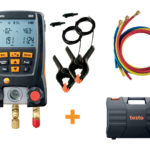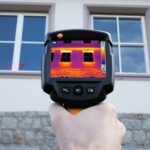A lux meter is used to measure light and has many useful industrial applications. It is important to understand what it is, how to calibrate it, and why Testo's lux meters are top of the line in order to use the tool effectively. Lighting is an important factor in any environment, not only in industrial settings but it also has an immense impact on office workers and corporate productivity.
What is a lux meter?
Lux meters measure brightness in lux, which is equivalent to one lumen per square meter. The device captures the light intensity in its sensor and relays the result in an internal memory system or data logger. Not only is the measurement of light intensity becoming increasingly important for safety reasons, but it can also increase workplace productivity in certain circumstances. In addition, your company can save money on the power supply by finding the right lighting levels for your budget. The same light bulb could last longer and be more efficient.
Light distribution is an important factor in occupational safety and employee performance. Lux meters help make sure that visible light conditions – in the office or in an industrial greenhouse, for example – are at optimal performance.
How to use a lux meter
Testo has different kinds of lux meters to suit your specific needs, each one with different capabilities. The testo 540 – Pocket-sized Lux meter, for example, has the capability to measure quick readouts all while being compact and having the perfect measurement range. While most of the meters have the same basic functionality of brightness and light measurement, some of them also have added features for different uses.
Lux meters from Testo measure light intensity and conditions extremely precisely, and they have three different components that ensure that the job is being done the right way. Here are some examples:
- Light sensor type: This is how the tools perceive ambient light in a similar way that the human eye does.
- V-Lambda curve: Lux meters that assess illuminance according to the V-Lambda curve are used for all common light sources.
- Operation: A light meter from Testo can be operated intuitively from the operation menu. Automatic data loggers increase the efficiency and precision of the measurement, and mistakes due to human error are avoided.
- Display size: The large display helps users ensure they can read the lux measurements quickly and accurately. This also helps to avoid errors when recording the measuring values, particularly when readings must be done right away.
Extended use features
As previously mentioned, the lux meters you can purchase from Testo have many extended use features to boost efficiency. Here are some examples:
- WiFi data loggers: When connected to the internet, the data loggers can store the information it records and detect when defined limit values are reached.
- External probes: For example, small lux probes are used in display cabinets and on exhibition pieces and offer discreet monitoring of light-sensitive exhibits.
When reading a lux meter, keep in mind that the number of lux gets smaller as the tool gets further away from the light source despite the fact that the amount of illuminance being emitted doesn't change. As you get further away, the light disperses making for a smaller light reading.
Choosing the right lux meter
There are several different measurement tool options and related products available from Testo, each one ideal for a different purpose. Here are a few top choices to pick from, depending on your situation and particular needs:
- Lux meter integrated into the WiFi data logger: This tool is the perfect measuring instrument for the long-term recording of data. Combine an air velocity & IAQ logger with an integrated lux sensor, temperature, humidity and UV sensors to make sure that comprehensive monitoring of the ambient lighting conditions and illumination in museums occurs.
- Multifunction measuring instruments with connectable probes: Similar to the above, lux meters often come with many other options and sensors for a multifunctional tool that measures several different parameters. The testo 400 – Universal IAQ instrument is a great example of this.
- Luxmeter with the built-in probe: The testo 540 pocket-sized lux meter is an example of a product that has built-in probes for measuring fixed items.
Lux meters have a wide range of uses but we know that you want your light level readings to be accurate and precise to ensure workplace safety and keep display items well preserved. Whatever the reason, there is no doubt that a measurement tool from Testo is available to make sure you receive the best information and tracked data with specially designed and wired equipment that can be adjusted by a professional to fill each need.
Contact Testo today to find the right lux light meter for you!









 Reduce cooking oil costs while ensuring quality
Reduce cooking oil costs while ensuring quality Expert knowledge on CO2 monitoring
Expert knowledge on CO2 monitoring Refrigeration knowledge - in 3 modules
Refrigeration knowledge - in 3 modules



